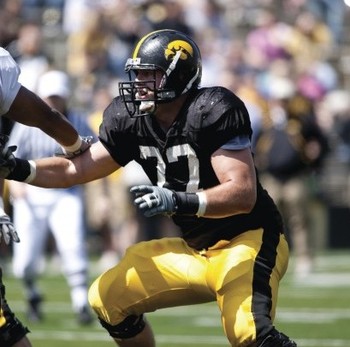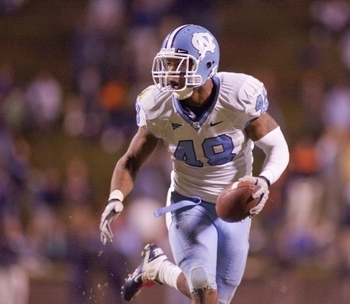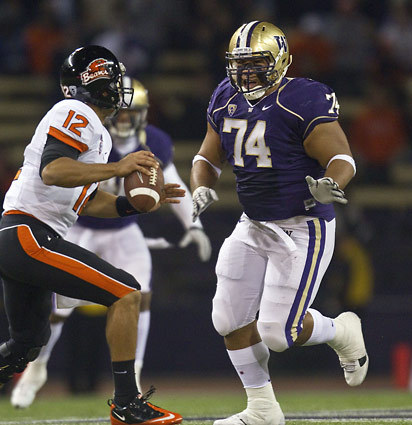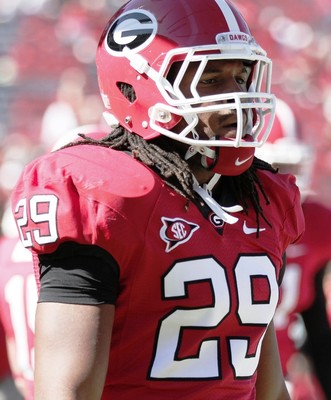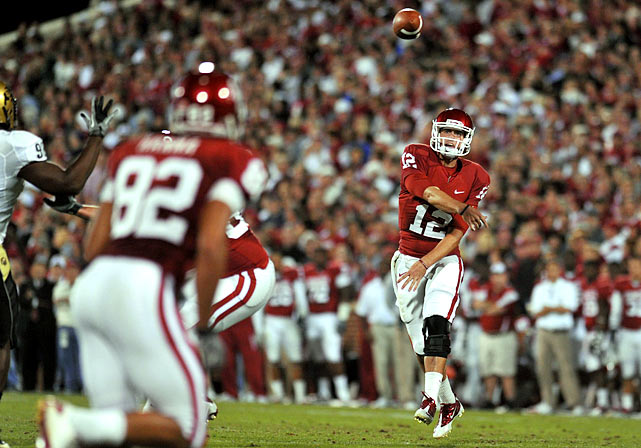
The Heisman winner in Seattle? It's not quite so unrealistic anymore...
The Seahawks are a coin-toss away from the #11 overall pick in April, yet most people have given up on the Seahawks drafting a quarterback in round one. I was one of those people. After a big win on the road against Chicago, I presumed the Seahawks would win one of their last two games. I’m not sure many people anticipated two NFC West defeats to end the regular season, which pushed Seattle up to the fringes of the top-ten. Time to review this particular situation.
There are essentially two quarterbacks worthy of being drafted early in round one. Andrew Luck will go first overall to Indianapolis, leaving the rest to scrap for Robert Griffin III. Ryan Tannehill and Landry Jones get a lot of unworthy hype, but as I’ve discussed at length, I wouldn’t take either in the first round. John Schneider was at the Alamo Bowl to watch Griffin take on Washington and in many ways the Baylor quarterback fits what Seattle has been looking for at the position. He’s mobile, he’s capable of extending plays, he limits turnovers and he’s got the arm to make difficult throws. Nobody can accuse Seattle of looking for perfection with the three quarterbacks they’ve acquired under the current regime (Tarvaris Jackson, Charlie Whitehurst and Josh Portis) but all share similar playing trends. Griffin is a more accomplished, more exiting model.
There’s an assumption doing the rounds that RG3 won’t last very long in round one. In fact, St. Louis are supposedly being primed to make a killing as teams jostle for position to draft the Heisman Trophy winner immediately after Luck leaves the board. I’m not going to rule that out and certainly Griffin’s hype-factor is through the roof at the moment. Not only is he a quarterback fans want to root for, but he’s a marketing dream with the potential to help sell a lot of tickets. He’ll test well at the combine, he’ll interview well and it’s no surprise that reports have surfaced that he’s going to turn pro. He’d be daft not to.
Even so, let’s not ignore the other side of the debate here which hasn’t been covered anywhere. What could lead to a fall, if anything?
The Washington game highlighted a couple of technical issues that haven’t always shown up this season. I sensed Griffin got a little impatient in the game and after a razor-sharp start, he was contained by the Huskies (even if they couldn’t stop the run and the steady stream of points). Feeling frustrated and wanting to make things happen, Griffin tried too hard. Suddenly he was moving around in the pocket trying to make unrealistic runs, bailing on the pass too early and losing a lot of his poise. Baylor scaled down their offense to take advantage of soft coverage and went to a heavy screen game – a staple used prior to the 2011 season that limited Griffin’s grade coming into this year. He didn’t look like a spectacular playmaker and was outshone by his opposite number – Keith Price. He’s also not working within an offense comparable to what he’ll find in the NFL and there’s a learning curve to combat especially if he’s expected to start quickly.
Although he generally makes good decisions, like most college quarterbacks he isn’t being asked to make pre-snap reads and adjustments. There are footwork issues he needs to solve when setting to throw, because he wastes too many steps on the drop back and dances too much in the pocket. Some teams will question the throws he’s making this year – although there’s been some sensational plays, the bulk of his throws are downfield lobs to utilise the extreme speed Baylor has at receiver and there’s a lot of comeback passes on bootlegs or scrambles, or simple screens and digs.
Griffin made enough mind-blowing plays for a lot of teams to see beyond this. However, it’s worth noting a possible flaw or two considering all of the non-stop hype everywhere else. Perhaps it won’t be any fault of Griffin’s ifhe falls? Maybe there’ll be reasons beyond his control that see him take a slight drop?
Indianapolis are clearing house after a 2-14 season – firing Vice Chairman Bill Polian and GM Chris Polian. Head Coach Jim Caldwell could also be on the way out. This is a big step for the Colts, who appear to be preparing for a new era at the franchise. Tellingly, the usually conservative Peyton Manning spent eight minutes with reporters after yesterday’s defeat to Jacksonville talking about the future. He acknowledged the Colts had to act and would do whatever they think is best. Manning sounded resigned to a future where he isn’t the heartbeat of theset-up. This is soon to be Andrew Luck’s team, with everything built around his future success.
Although Bill Irsay says Luck and Manning can c0-exist, the writing is on the wall. Due $28m before the new league season begins, Manning will be cut or traded before Indianapolis is footing the bill. It’ll create a scramble for a future hall-of-fame quarterback who, if healthy, could turn a team into an instant contender within their division and maybe even their conference. I’ve made the point many times on this blog, but doesn’t this just scream for Washington to make a move? Dan Snyder loves a free-agent splash and making Manning a Redskin would be a major coup. Suddenly, Washington would be in the NFC East mix. Mike Shanahan has endured two pretty miserable seasons so far as Head Coach, but adding Manning would suddenly make his offense relevant.
Sure, heisn’t the prototype quarterback Shanahan usually acquires – but this is Peyton Manning we’re talking about here. Washington can’t sit around hoping that Griffin will fall beyond Cleveland come April – they have to act. They could sign Manning and plan to go in a different direction in round one. The Redskins could still draft a younger quarterbacklike Ryan Tannehill, who should be around at the top of round two unless there’s a ridiculous Christian Ponder-type reach. By adding Manning, drafting a player such as Riley Reiff to play right tackle and then adding Tannehill as a developmental successor, Washington could have a direction for the future but also a short term plan to be competitive in the NFC East.
It’s not a ridiculous suggestion, in fact I think it’s fairly logical when you think about it. It’d also take the Redskins out of contention for Griffin.
The team in pole position to draft RG3 is of course Cleveland, who own the #4 overall pick. Colt McCoy hasn’t worked out (why did anyone ever think otherwise?) and they need a quarterback desperately. The Browns have two first round picks meaning they could draft Griffin and still improve another area of their team in round one. However, is there a possibility Cleveland could look to fill their quarterback void elsewhere? Let’s not forget how Mike Holmgren went about his work in Seattle. He hand picked a quarterback from his former employer and despite a bargain price, turned Matt Hasselbeck into a Pro-Bowler and Super Bowl quarterback. Already he’s avoided the position early in consecutive drafts, only to spend a mid-round tester on McCoy. Will he see Griffin as an unmissable talent for his master plan? Or will he believe there are other options out there? After all, this is a Cleveland team with very little offensive playmaking talent.
Griffin alone could be swallowed up, but go and sign Matt Flynn and realistically you could draft Trent Richardson and a first round receiver too. Then you’re looking at a quarterback with some of the technical qualities Holmgren likes, but not the physical brilliance of Griffin. You’ve got a playmaker capable of becoming a superstar in Richardson and a big bodied receiver (Alshon Jeffrey? Michael Floyd?) to help Greg Little. While the running back position is becoming less important in terms of draft stock, let’s not rule out the possibility of a team falling in love with Richardson as much as many expect teams to fall in love with Griffin. The relatively cheap price of a top-five pick these days could make for a more dynamic impact with Richardson pounding the rock in the AFC North and Flynn acting as the string-puller. Too far fetched? Maybe not.
If these two scenarios came true (run with it) it would leave Miami at #9 as the next obvious home for RG3. Suddenly, you could be looking at a situation where the Carolina Panthers are on the clock at #8 and the Seahawks would only need to move up three spots to usurp the Dolphins. The old trade value chart says Seattle would need to make up 150 points, essentially the price of a late third round pick. The Seahawks haven’t had a third round choice in the last two drafts, yet have still managed to find plenty of talent in the later rounds. If Seattle traded it’s early third round pick, they could probably get a 5th rounder out of the deal to soften the blow. It’s hardly a trade that will ruin the future of your franchise, especially if you believed Griffin had the potential to finally end the tedious debate as to who will be Seattle’s quarterback of the future.
A lot would need to happen for this to become reality – not to mention the possibility that other teams could also look to move up and might be willing to spend big in order to do so. However, there was a lot of hype about Blaine Gabbert last April. People might not recognise it considering Gabbert’sstruggles this year, but there was talk he could go first overall and wouldn’t make it out of the top five. At one point, reports suggested Washington were aggressively trying to trade up to draft him in the top-three. As it happens, the Redskins passed up the chance to draft him with their own pick and Gabbert went fell to the #10 pick – a surprise at the time. Although we expect Griffin to go very early – and people expect Griffin to be a better pro than Gabbert has so far – let’s try not to assume anything just yet.
Picking in the late teens would’ve made any potential trade a blockbuster – multiple picks, two first rounders. It would’ve handcuffed the Seahawks – and Pete Carroll – to Griffin and his success or failure. I’d guess this franchise wouldn’t be prepared to make such a move, a risk that seems out of character. Whether Seattle picks at #11 or #12, suddenly such a deal is no longer so unrealistic. According to the chart, for the price of their second rounder they have enough to get up to #5 or #6. If the Seahawks like RG3 enough to make him ‘the guy’, putting a deal together to bring him to the North West may not cost quite as much as people first thought. Is he in play for the Seahawks? Why not?













